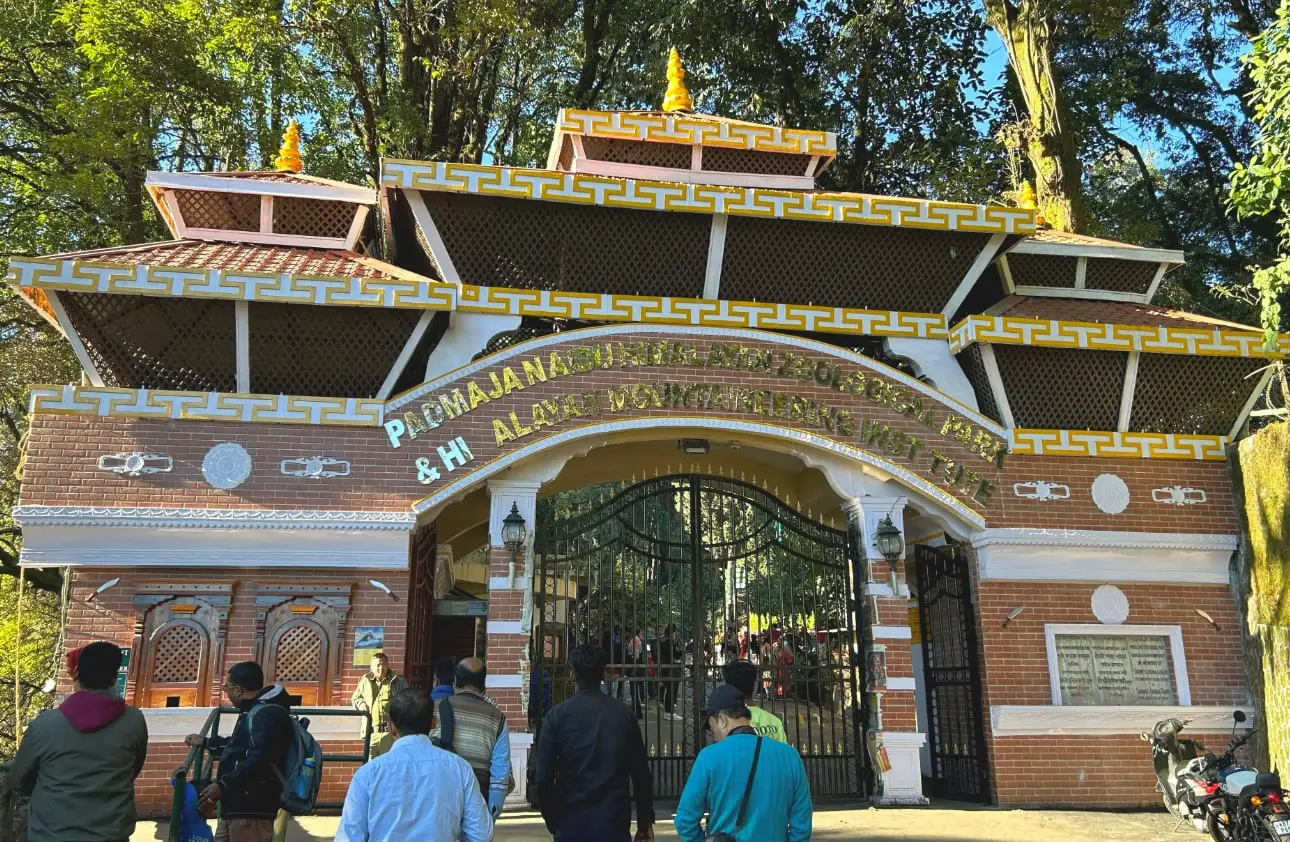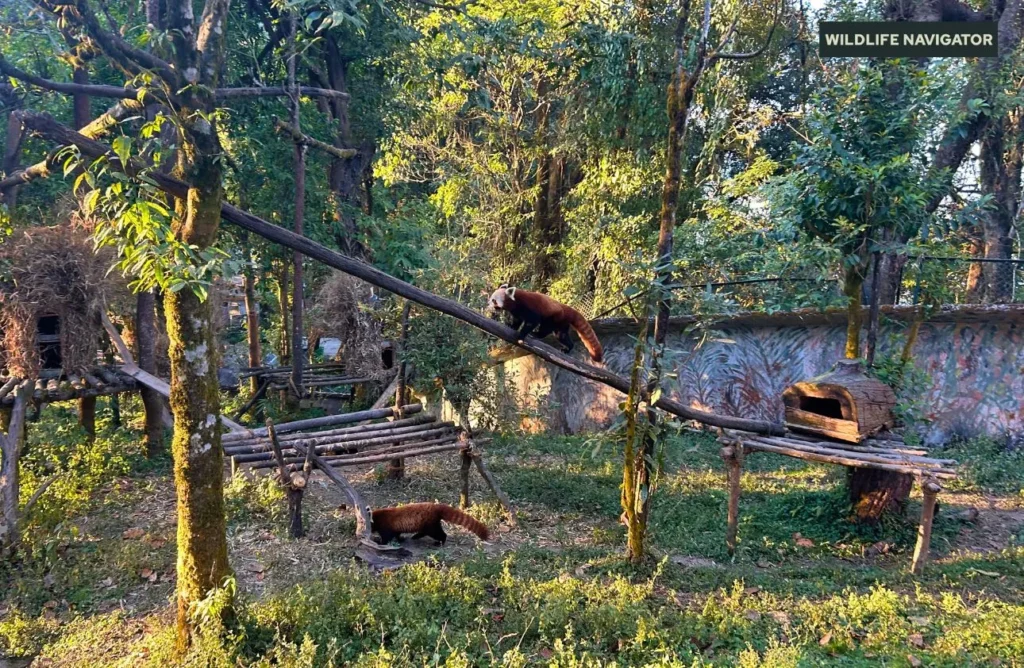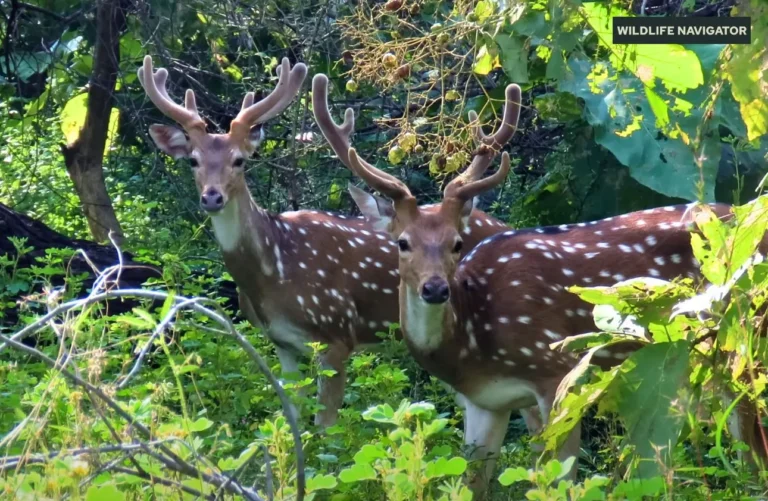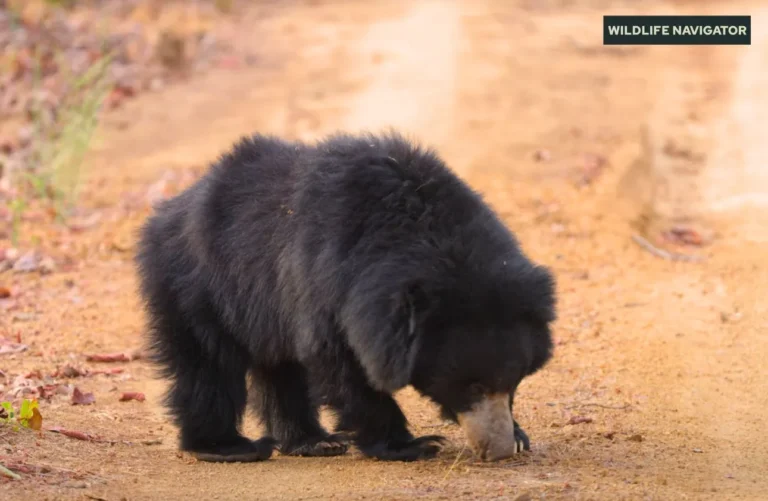Darjeeling Zoo | Padmaja Naidu Himalayan Zoological Park

Padmaja Naidu Himalayan Zoological Park, often referred to as Darjeeling Zoo, is a prime destination for wildlife enthusiasts visiting Darjeeling.
The Padmaja Naidu Himalayan Zoological Park (PNHZP) stands as one of India’s most distinguished high-altitude zoos in the serene hills of Darjeeling, West Bengal. Spanning around 67 acres, it offers visitors a rare opportunity to experience the wildlife of the Himalayan region in their near-natural habitats. Unlike many conventional zoos, PNHZP specialises in species that thrive in cooler climates and mountainous terrains, making it a unique destination for wildlife enthusiasts, researchers, and nature lovers.
The zoo is particularly famous for its snow leopards and red pandas, both of which are highly elusive in the wild. Visitors often marvel at the park’s beautifully landscaped enclosures that mimic the natural environment of the Himalayas, with terraced gardens, rocky terrains, and lush greenery. Its commitment to conservation and education has earned it a reputation not only as a tourist attraction but also as a centre for wildlife preservation.
Whether you are a wildlife photographer, a family seeking an educational outing, or a conservationist keen to learn about Himalayan species, Darjeeling zoo offers an immersive and enriching experience. From observing rare animals in thoughtfully designed habitats to learning about high-altitude wildlife conservation, every visit is both inspiring and informative.
History and Background
The Padmaja Naidu Himalayan Zoological Park was established in 1958, originally known as the Darjeeling Zoo. It was later renamed in 1975 to honour Padmaja Naidu, the daughter of Sarojini Naidu and the then Governor of West Bengal, who was also an ardent supporter of wildlife conservation.
The idea behind creating this zoo was not just to entertain visitors, but to build a specialised centre for high-altitude Himalayan wildlife, something that was missing in India at the time. The founders wanted a place where rare and endangered mountain species—like the snow leopard, red panda, and Himalayan wolf—could thrive, breed, and be studied under semi-natural conditions.
Over the decades, the zoo has grown from a small regional attraction into an internationally recognised conservation hub. In 1986, the Central Zoo Authority of India designated it as the Central Zoo for Breeding of Endangered Himalayan Species, cementing its role as a pioneer in wildlife preservation.
Some key milestones in its journey include:
- 1970s: Expansion of enclosures to accommodate rare species from across the Himalayas.
- 1980s: Launch of successful snow leopard and red panda breeding programs, which brought global attention to the zoo.
- 1990s–2000s: Collaboration with international organisations for research and conservation projects.
- Present Day: Recognised as one of the best-managed zoos in India, attracting researchers, conservationists, and tourists from around the world.
The zoo is not just a tourist destination—it has evolved into a living laboratory for conservation, ensuring that Himalayan wildlife, much of which faces severe threats from climate change and habitat loss, has a fighting chance for survival.
Geography, Landscape & Climate
The Padmaja Naidu Himalayan Zoological Park is uniquely situated in the hill town of Darjeeling, West Bengal, at an altitude of around 7,000 feet (2,134 meters) above sea level. Its location in the eastern Himalayas provides a naturally cool and misty environment, perfectly suited for the survival of high-altitude species that struggle to adapt in lowland or warmer conditions.
Spread across 67 acres, the zoo is designed in harmony with its surroundings. Unlike many flat-terrain zoos, PNHZP is built on a terraced hillside, which not only provides stunning views of Darjeeling town and the surrounding mountains but also creates a naturalistic environment for the animals. Enclosures are carefully integrated into rocky slopes, forested patches, and green valleys to replicate the natural habitats of the species housed here.
The landscape is dotted with tall Himalayan trees such as oak, birch, and magnolia, along with vibrant seasonal flowers that bloom across the park, making it as much a botanical delight as a zoological one. The paths for visitors wind gently up and down the hillside, offering shaded walks and resting points where one can enjoy both the animals and the panoramic scenery.
The climate here is another defining feature. With cool summers, mist-laden monsoons, and chilly winters, the weather is ideal for animals such as the snow leopard, red panda, and Tibetan wolf, which naturally thrive in alpine and subalpine conditions. Unlike lowland zoos, where Himalayan species often struggle, PNHZP provides a near-natural environment year-round.
This geographical advantage not only helps in maintaining the health and breeding of rare species but also gives visitors an authentic glimpse into the Himalayan ecosystem. Walking through the zoo often feels less like visiting an artificial animal park and more like stepping into a living, breathing part of the Himalayas itself.
Animals and Species Highlights
The Padmaja Naidu Himalayan Zoological Park is home to a unique collection of Himalayan and high-altitude wildlife, many of which are rarely found in other zoos worldwide. Its enclosures replicate natural habitats, allowing animals to thrive in Darjeeling’s cool climate.
Big Cats of the Himalayas
- Royal Bengal Tiger: India’s iconic predator, symbolising strength and power.
- Snow Leopard: The crown jewel of the zoo, celebrated for its elusive nature and conservation success here.
- Siberian Tiger: One of the largest tiger subspecies, adapted to extreme cold climates.
- Clouded Leopard: Known for its striking coat and tree-climbing skills.
- Indian Leopard & Leopard Cats: Agile hunters that represent the adaptability of wild cats across Asia.
Himalayan Canids & Carnivores

- Red Panda: The most famous resident, adored by visitors for its playful, tree-dwelling lifestyle.
- Himalayan Wolf: A rare high-altitude wolf subspecies, vital for Himalayan ecosystems.
- Jackals and other smaller carnivores also have enclosures showcasing the diversity of predators.
Mountain Herbivores
- Himalayan Tahr: A sturdy wild goat with a thick coat adapted for rocky slopes.
- Goral: A small, agile goat-antelope found on steep Himalayan cliffs.
- Blue Sheep (Bharal): A key prey species for snow leopards, important in mountain food chains.
- Yak: A Domesticated high-altitude animal, displayed to highlight the Himalayan culture.
Bird Species in the Zoo
Although the zoo is more famous for its animals, it also houses fascinating high-altitude Himalayan birds such as:
- Himalayan Monal: A vibrant pheasant and the state bird of Uttarakhand.
- Satyr Tragopan: Known as one of the most beautiful pheasants in the world.
- Blood Pheasant: A rare, high-altitude bird with striking red plumage.
- Vultures & Eagles: Majestic scavengers and raptors crucial to mountain ecosystems.
Reptiles & Smaller Species
Although less famous, PNHZP also houses a selection of reptiles, amphibians, and small mammals, highlighting ecosystem diversity:
- Turtles & Lizards adapted to the Himalayan foothills.
- Himalayan Newts and Frogs represent cold-climate amphibians.
- Porcupines, Civets, and Martens are among the smaller mammals that are vital yet often overlooked.
These creatures may not attract as much attention as snow leopards or red pandas, but they play crucial ecological roles in balance and biodiversity.
Conservation, Breeding & Research Programs
The Padmaja Naidu Himalayan Zoological Park is not just a place to see animals — it is a pioneer in wildlife conservation, particularly for high-altitude and endangered species. Its role as the Central Zoo Authority’s coordinating zoo for Himalayan species conservation makes it one of the most important wildlife institutions in India.
Here’s a detailed look at its initiatives:
Snow Leopard Breeding Program
Since the 1980s, PNHZP has been at the forefront of the snow leopard captive breeding project, one of the most successful in the world. The cool, alpine-like climate of Darjeeling provides ideal conditions for this big cat, allowing the zoo to rear and breed multiple generations in captivity. The program contributes significantly to global snow leopard conservation efforts.
Red Panda Conservation
Perhaps the zoo’s most celebrated achievement is its red panda breeding program. Red pandas are extremely vulnerable to habitat loss and climate change, and their numbers in the wild are declining rapidly. PNHZP has successfully bred several cubs, some of which have been reintroduced into the forests of Sikkim and Darjeeling, giving the species a fighting chance at survival.
Tibetan Wolf and Other Predators
The zoo is also one of the few places globally working on the captive management and research of Tibetan wolves. By studying their behaviour, genetics, and dietary patterns, the zoo contributes valuable data that can aid in their long-term conservation in the wild.
Birds, Pheasants, and Vultures
The zoo plays a crucial role in conserving Himalayan bird species such as the Himalayan monal, satyr tragopan, and several endangered vultures. These birds face serious threats in the wild due to hunting, poisoning, and habitat loss. Breeding programs at the zoo aim to secure their future.
Research and Collaboration
PNHZP collaborates with national and international institutions, including the Central Zoo Authority, World Association of Zoos and Aquariums (WAZA), and wildlife research centres. Its research focuses on:
- High-altitude animal behaviour.
- Genetic diversity and population management.
- Reintroduction strategies for species like red pandas.
Education and Awareness
Beyond breeding, the zoo also conducts awareness campaigns, workshops, and conservation education programs for schools, colleges, and tourists. These efforts help spread the message of wildlife protection to a larger audience.
In essence, PNHZP is not just preserving animals behind enclosures — it is actively fighting extinction through science, collaboration, and rewilding efforts. This makes it one of the most important centres for ex-situ conservation in South Asia.
Exhibits, Attractions & Activities
A visit to the Padmaja Naidu Himalayan Zoological Park is much more than just walking past enclosures — it’s an immersive journey into the Himalayan wilderness. The exhibits are thoughtfully designed to replicate natural habitats, making the zoo feel like a living extension of the mountains themselves.
Here’s what makes the visitor experience so engaging:
Major Enclosures
- Snow Leopard Habitat: The star attraction, where visitors can watch these rare big cats resting on rocky ledges or pacing through their naturalistic enclosures.
- Red Panda Sanctuary: One of the most loved areas, this enclosure resembles a miniature Himalayan forest with trees, logs, and hiding spaces, perfect for spotting the shy and playful red pandas.
- Predator Zones: Housing Himalayan wolves, Tibetan wolves, and black bears, these sections provide a chance to observe elusive carnivores up close.
- Ungulate Sections: Featuring the Himalayan tahr, blue sheep (bharal), and yak, offering insight into the herbivores of the Himalayas.
- Bird Aviaries: Colourful enclosures filled with Himalayan monals, kalij pheasants, tragopans, and vultures, where their plumage and calls captivate visitors.
Attractions
- Naturalistic Design: Instead of cages, many animals are housed in open, landscaped enclosures separated by moats or glass, enhancing the sense of authenticity.
- Botanical Beauty: The zoo doubles as a botanical delight, with magnolias, oaks, rhododendrons, and seasonal blooms decorating the pathways.
- Panoramic Views: From certain vantage points, visitors can catch breathtaking glimpses of Darjeeling town, rolling hills, and even snow-capped peaks on clear days.
Activities & Learning Experiences
- Guided Tours: Trained staff and guides offer detailed insights about the animals, their behaviour, and conservation challenges.
- Educational Exhibits: Panels and displays throughout the zoo provide fascinating facts about the species, ecosystems, and ongoing conservation programs.
- Seasonal Events: The zoo hosts events on World Environment Day, Wildlife Week, and International Red Panda Day, engaging visitors with awareness campaigns, art contests, and conservation talks.
- Photography Workshops: Occasionally organised for wildlife enthusiasts to capture animals in naturalistic settings.
Family-Friendly Experience
The zoo is designed to be engaging for all age groups. Children enjoy spotting the red pandas and colourful birds, while adults often appreciate the conservation-oriented exhibits. The peaceful, shaded pathways also make it an enjoyable walk for families and nature lovers.
In short, every corner of Darjeeling Zoo offers a mix of entertainment, education, and inspiration, making it not just a zoo but a window into the Himalayan wilderness.
Visitor Information & Tips
Before planning a trip to the Padmaja Naidu Himalayan Zoological Park, it’s useful to know the essential details that will make your visit smooth and enjoyable. The zoo is well-managed, but because of its hillside terrain and unique climate, preparation is key.
Opening Hours
- The zoo is usually open from 8:30 AM to 4:30 PM.
- Closed on Thursdays (and sometimes on specific public holidays).
- It’s best to confirm timings in advance, as seasonal variations may occur.
Entry Fees, Ticket Price & Booking
- Indians & SAARC (Adults): ₹110 per person
- Foreign Nationals: ₹180 per person
- Children below 6 years: Free
- Entry is usually combined with the Himalayan Mountaineering Institute (HMI) museum located inside the same campus, giving visitors a two-in-one experience.
- Tickets are available at the entry gate; online booking is available through the official WBZA site.
Ticket Booking Link Official: West Bengal Zoo Authority
Accessibility
- The zoo is built on a hillside with steep paths and stairs. While it’s scenic, it can be physically challenging for elderly visitors or those with mobility issues.
- Comfortable walking shoes are highly recommended.
- Wheelchair accessibility is limited due to the terrain.
Best Time to Visit
- Spring (March–May): Flowers bloom across the zoo, and animals are active.
- Autumn (September–November): Clear skies and pleasant temperatures.
- Winter (December–February): Cold but perfect for Himalayan animals like snow leopards and red pandas, which are more active.
- Monsoon (June–August): Avoid if possible, as heavy rain and mist can limit visibility and make paths slippery.
Visitor Tips For Darjeeling Zoo
- Start Early: Morning hours are best to spot active animals before the crowds arrive.
- Clothing: Carry a light jacket or sweater even in summer, as Darjeeling weather can be unpredictable.
- Photography: Bring a camera with a good zoom lens for clear shots of animals in naturalistic enclosures.
- Food & Drink: Carry bottled water and light snacks; however, feeding animals is strictly prohibited.
- Respect Wildlife: Maintain silence near enclosures, avoid tapping glass, and follow all zoo guidelines.
Nearby Attractions & Travel Guide
A trip to Padmaja Naidu Himalayan Zoological Park can easily be combined with exploring other gems of Darjeeling, making it a full-fledged travel experience.
How to Reach
- By Air: Nearest airport is Bagdogra (70 km), connected to major Indian cities.
- By Train: Nearest railway station is New Jalpaiguri (NJP, 75 km).
- By Road: Shared jeeps, private taxis, and buses connect Siliguri and NJP to Darjeeling.
- From Darjeeling town, the zoo is about 2 km uphill, accessible by car or on foot.
Accommodation Nearby
Darjeeling offers a range of options:
- Luxury Hotels: Mayfair Darjeeling, Windamere Hotel.
- Mid-range: Summit Swiss Heritage, Central Heritage.
- Budget Stays & Homestays: Cosy family-run options with local hospitality.
Nearby Attractions
- Himalayan Mountaineering Institute (HMI): Located inside the zoo campus, with a world-class mountaineering museum.
- Darjeeling Himalayan Railway (Toy Train): A UNESCO World Heritage attraction.
- Tiger Hill: Famous for sunrise views over Mt. Kanchenjunga.
- Batasia Loop: A scenic railway loop with gardens and a war memorial.
- Darjeeling Mall (Chowrasta): The town’s central square for shopping, food, and local culture.
Travel Tips
- Weather changes quickly, so pack layers.
- Carry cash, as smaller shops may not accept cards.
- Try local delicacies like Darjeeling tea, momos, and thukpa while exploring the town.
With its proximity to major attractions, a visit to PNHZP can easily fit into a 2–3 day Darjeeling itinerary, blending wildlife, culture, and Himalayan beauty.
Conclusion
The Padmaja Naidu Himalayan Zoological Park is far more than a typical zoo — it is a sanctuary of the Himalayas, where conservation meets education and natural beauty. From its iconic snow leopards and red pandas to its rare Himalayan birds and wolves, the zoo offers an extraordinary chance to witness species that most people would never encounter in the wild.
What truly sets it apart is its commitment to conservation. With successful breeding programs, global collaborations, and reintroduction efforts, PNHZP plays a critical role in saving endangered species from the brink of extinction. For visitors, it is both an educational journey and an unforgettable adventure into the biodiversity of the high mountains.
Whether you are a wildlife enthusiast, a family traveller, or someone seeking a peaceful walk through Himalayan nature, the zoo promises a rewarding experience. Combined with nearby Darjeeling attractions, it makes for a complete Himalayan escape.
So, the next time you plan a trip to Darjeeling, make sure to add Padmaja Naidu Himalayan Zoological Park to your itinerary — not just to see animals, but to be inspired by the incredible efforts being made to protect our planet’s fragile mountain ecosystems.





